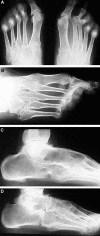Juvenile onset spondyloarthropathies: therapeutic aspects
- PMID: 12381509
- PMCID: PMC1766731
- DOI: 10.1136/ard.61.suppl_3.iii33
Juvenile onset spondyloarthropathies: therapeutic aspects
Abstract
Juvenile onset spondyloarthropathy (SpA) is a term that refers to a group of human leucocyte antigen (HLA)-B27 associated inflammatory disorders affecting children under the age of 16 years, producing a continuum of clinical symptoms through adulthood. This disease is characterised by enthesopathy and arthropathy affecting the joints of the lower extremities and seronegativity for IgM rheumatoid factor and antinuclear antibodies. Children usually present with undifferentiated SpA and progress to differentiated forms over time. Except for the prevalence of some clinical features at onset, the pathogenic and clinical aspects of juvenile onset SpAs resemble those of the adult disease. Thus application of the same or similar therapeutic measures for both juvenile and adult onset SpAs seems logical. Current treatments for juvenile onset SpA provide symptomatic improvement, but do not alter disease progression. The increased expression of tumour necrosis factor alpha (TNFalpha) in synovial tissue of patients with adult and juvenile onset SpA and its correlation with infiltration of inflammatory mediators into the synovia suggest a significant pathogenic role of this cytokine. Clinical trials of anti-TNFalpha antibody (infliximab) therapy in patients with adult onset SpA have demonstrated significant clinical improvement in inflammatory pain, function, disease activity, and quality of life in correlation with histological and immunohistochemical evidence of modulation of synovial inflammatory processes. These promising findings suggest that anti-TNFalpha therapy may confer similar benefits in patients with juvenile onset SpA.
Figures



References
Publication types
MeSH terms
Substances
LinkOut - more resources
Full Text Sources
Research Materials

